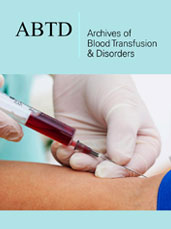- Submissions

Abstract
Archives of Blood Transfusion & Disorders
Prevalence of Hepatitis B Surface Antigen and Hepatitis B Core Antibody Among Prospective Blood Donors in Abuja, Nigeria
-
Open or Close Ben Ikerionwu*
Nigeria
*Corresponding author: Ben Ikerionwu, Nigeria
Submission: January 08, 2018; Published: November 27, 2018

ISSN: 2578-0239Volume1 Issue4
Abstract
Background: Hepatitis B (HB) virus (HBV) remains a major risk factor for safe blood use. Compulsory pre-transfusion screening for HB core antibody (anti-HBc) to detect occult HBV infection (OHBVI) in HB surface antigen (HBsAg-)negative persons and prevent post-transfusion HBV infection in the target area is an unmet need. This study aimed to evaluate the presence of HBsAg and anti-HBc in prospective blood donors in Abuja, Nigeria and determine their association with age, gender, marital status (MS) and education.
Methods: We evaluated the presence of Total anti-HBc positivity and HBsAg-status among blood donors using the principle of enzyme-linked immunoassay (ELISA) method; and analysed their association with age, gender, MS and education using chi-squared (X2) test. The results were presented in simple tables and figures. A total of 300 individuals participated in the study. The p-value was set at P< 0.05 as significant level.
Result: Data for 300 participants were analysed with male: female dominant ratio of 24:1, recording prevalence of 7.7% (HBsAg+) and 17.7% (anti-HBc). Age group 25-34 years had the highest prevalence: 3.7% for HBsAg+ and 8.3% for anti-HBc; participants with formal education had higher prevalence for HBsAg+ (6.7%), anti-HBc (14.3%) than informal education (1.0% and 3.3%) respectively. Married participants recorded higher prevalence for HBsAg+(6.0%) and anti-HBc (14.0%) than unmarried participants (1.7% and 3.6%) respectively. Anti-HBc positive without HBsAg+ positivity was recorded among 10% of the participants. There was no significant association between prevalence of the markers and the demographic variables studied.
Conclusion: The high prevalence of anti-HBc (17.6%) among HBsAg+(7.7%) and (10%) among HBsAg-negative noticed in this study showed that the virus is actively replicating in chronic HBV carriers and persistently enhancing silent spread within the population in the target area.
Keywords: Prevalence; HBsAg; Anti-ssssHBC; Pre-transfusion screening; Abuja; Nigeria
 a Creative Commons Attribution 4.0 International License. Based on a work at www.crimsonpublishers.com.
Best viewed in
a Creative Commons Attribution 4.0 International License. Based on a work at www.crimsonpublishers.com.
Best viewed in 







.jpg)






























 Editorial Board Registrations
Editorial Board Registrations Submit your Article
Submit your Article Refer a Friend
Refer a Friend Advertise With Us
Advertise With Us
.jpg)






.jpg)














.bmp)
.jpg)
.png)
.jpg)










.jpg)






.png)

.png)



.png)






